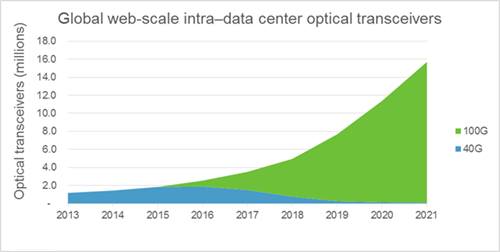Transceivers like Cisco SFP+, Juniper SFP+ are always used for deploying 10G Ethernet network, while transceivers like Cisco QSFP+, Juniper QSFP+ are chosen to deploy 40G Ethernet network if the network capacity and speed provided by the 10G Ethernet network are not able to meet our need. However, as our requirements for larger network capacity and higher network speed never stop, what should we do when the 40G Ethernet network can not satisfy our requirements any more? The answer is 100G Ethernet network, which is just a preferable solution to accelerate network speed for those bandwidth-hungry applications.
Benefits from 100G Ethernet Network
Since the 100G Ethernet network has been designed and put into use, the need for deploying 100G Ethernet network is always on the rise that can be learned from the following figure. What’s more, it is predicted that over half of the data center will migrate their systems to 100G Ethernet networks in near future. What makes the 100G Ethernet network so popular? What can we benefit from it? Let’s explore the advantages of deploying 100G Ethernet network.

In general, the advantages of 100G network can be concluded in four aspects. First and foremost, 100G network has the merits of expansion and scalability which is designed to support the reliability, manageability and flexibility of modern network while prepared for the bandwidth and speed requirements of future network. Due to allow for network changes in the future, 100G network can be still regarded as future-proofing network. Secondly, as a cost effective solution to greatly expand the network capacity, it features unsurpassed bandwidth and can be available at a compelling price. Thirdly, it is the first choice across long-haul networks for its large capacity and fast network speed that can be customized, optimized, and easily expanded to meet the future use. And finally, with the popularity of network transition from 10G/40G to 100G network, the 100G network technology is continuing to mature, which undoubtedly drives down the cost of 100G devices, such as QSFP28 transceiver modules and QSFP28 cables.
QSFP28 Transceiver—an Ideal Solution for 100G Ethernet Network
At present, there are several kinds of 100G transceivers, such as, QSFP28, CFP, CFP2 and CFP4, designed for different applications where the 40G transceivers can’t meet the requirements any longer. Among these 100G transceivers, the QSFP28 transceiver is the most widely used one which should be attached importance to for owning a fast, smooth and stable 100G network.
Similar to the QSFP+ transceiver that features four 10Gbps lanes to finish 40G transmission, the QSFP28 transceiver is also designed with four lanes, each of which transmits 25Gbps signal to achieve the whole 100G transmission and even supports the signal up to 28Gbps with an upgrade electrical interface. Meanwhile, the footprint and faceplate density of the QSFP28 transceiver are the same as those of the QSFP+ transceiver, but its advantages of higher density, lower power consumption and lower price per bit make itself superior to the QSFP+ transceiver.
FAQ for Using QSFP28 to Deploy 100G Ethernet Network
When using QSFP28 to deploy 100G Ethernet network, you may be confused about some questions. For instance, why we should choose this kind of 100G transceiver? What is the difference between QSFP28 and QSFP+ transceiver? And how many QSFP28 transceiver modules can be fitted into one switch? The following will give you the answers for these problems, which may be useful for you to deploy a fast, smooth and stable 100G network.
Why we should choose QSFP28 transceiver to deploy 100G network? In contrast to other 100G transceivers like CFP family, QSFP28 has greatly increased the panel density and decreased power consumption which can save cost a lot. For example, the increase in density is even more dramatic when compared to other 100Gbps form factors, such as, 450% versus the CFP2. For this reason, it is highly recommended to use QSFP28 to deploy our 100G network.
What is the difference between QSFP28 and QSFP+ transceiver? These two transceiver modules have the same size form factor and the number of ports, while the lane speeds of QSFP28 transceiver are increased from 10 Gbps to 25 Gbps. Hence, the QSFP+ transceiver is always used for 40G transmission with the four 10 Gbps lanes, but QSFP28 transceiver features four 25 Gbps lanes to achieve 100G transmission.
How many QSFP28 transceiver modules can be fitted into one switch? Just taking the one rack-unit (RU) switch as an example, it generally accommodates up to 36 ports for QSFP28 transceiver modules. In addition, there are also many other kinds of transceivers and cables (DACs and AOCs) can be plugged into these ports.
Conclusion
100G Ethernet network is definitely a preferable solution to accelerate network speed and expand the network capacity, which is strongly suggested for those bandwidth-hungry applications. Meanwhile, QSFP28 transceiver module is the ideal choice to deploy the 100G network for large scale data centers, as well as future network expansions, which features higher port density, lower power consumption and lower cost. Since there have been several kinds of QSFP28 transceiver modules available on the market for different application, if you want to choose one proper QSFP28 transceiver for deploying your 100G network, you can visit this article that shows the basic knowledge of common QSFP28 transceiver modules.